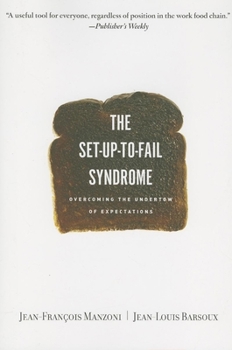Set-Up-To-Fail Syndrome: Overcoming the Undertow of Expectations
Select Format
Select Condition 
Book Overview
Do you have an employee whose performance keeps deteriorating--despite your close monitoring? Brace yourself: You may be at fault--by unknowingly triggering the set-up-to-fail syndrome. Perhaps things started off swimmingly. But then something--a missed deadline, a lost client--made you question the person's performance. You began micromanaging him. Suspecting your reduced confidence, he started doubting himself--and stopped giving his best. You viewed his new behavior as additional proof of mediocrity, and tightened the screws further. In The Set-Up-to-Fail Syndrome , Jean-Francois Manzoni and Jean-Louis Barsoux show how this insidious cycle hurts everyone: employees stop volunteering ideas, preventing your organization from getting the most from them; you lose energy to attend to other activities; and your reputation suffers as other employees deem you unfair. Team spirit wilts as targeted performers are alienated. But the set-up-to-fail syndrome doesn't have to happen. The authors provide preventive measures, such as loosening the reins as new employees master their jobs. If the syndrome has already erupted, Manzoni and Barsoux explain how to discuss the dynamic with your employee and reverse the cycle.
Format:Paperback
Language:English
ISBN:142210284X
ISBN13:9781422102848
Release Date:February 2007
Publisher:Harvard Business Review Press
Length:304 Pages
Weight:0.70 lbs.
Dimensions:0.8" x 4.6" x 9.0"
Customer Reviews
1 rating
Counter-intuitive, but it makes perfect sense...
Published by Thriftbooks.com User , 17 years ago
The book The Set-Up-To-Fail Syndrome: Overcoming the Undertow of Expectations by Jean-Francois Manzoni and Jean-Louis Barsoux is one of those titles that presents a concept that is counter-intuitive to most managers. But once you have it explained, the light comes on and you realize just how correct the idea is. Contents: The Set-Up-To-Fail Syndrome; When Common Sense Fails Us; Set-Up-To-Fail - A Vicious Cycle; Labels, Biases, and Misperceptions; Colluding to Collide; The Cost Iceberg; Blinders of Our Own Making; Cracking the Syndrome; Preventing the Set-Up-To-Fail Syndrome - Lessons from the "Syndrome Busters"; Getting There; Notes; Index; About the Authors The idea here involves what happens to underperforming employees when their supervisors attempt to "help" them. The supervisor sees that a particular employee isn't at the level that's expected. Their natural first step is to start coaching them, offering feedback on how to perform better. But in far too many cases, the employee resents the implications of underperformance. This leads to either withdrawal from the job or hesitancy to make decisions for fear of making a mistake. These actions reenforce the judgement of the supervisor, leading to more "help". At that point, the downward spiral has begun, with little chance of improvement. Both sides become entrenched in their mental framework. So instead of helping an employee improve, the supervisor has unwittingly set them up for failure. The authors describe this situation in all-too-familar clarity, and I was amazed at how much sense it made once you changed your perspective. It was scary to see their research on how quickly these underperformance impressions are formed. In many cases, these signals start coming from the boss within hours. What's worse is that the residual damage can go on for years, even after the situation is resolved in one way or another. The Cracking chapter puts forth a solid format for breaking the cycle, setting expectations on both sides, and how the results can be measured without the emotional baggage that so often comes with these scenarios. Even the simple act of being aware of the syndrome can dramatically change the way you practice your management style. In terms of being practical and useful, this book delivers solid value. It doesn't matter how big or small your business is, or whether you've been managing for years or weeks. After reading Set-Up-To-Fail, you'll be unable to offer feedback or coaching in the same way again... or at least you'll feel guilty if things don't work out the way you'd expect...





